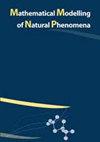利用指数递减释放避免毛触发效应的无菌昆虫技术的控制策略
IF 2.1
4区 数学
Q2 MATHEMATICAL & COMPUTATIONAL BIOLOGY
引用次数: 0
摘要
本文介绍了一种应用无菌昆虫技术(SIT)消灭伊蚊种群的控制策略,伊蚊是登革热、寨卡病毒、基孔肯雅病毒等各种致命疾病的媒介。。。在广阔的区域内。我们使用反应扩散方程组来模拟蚊子种群,并研究释放不育雄性的效果。在没有任何人为干预的情况下,由于所谓的毛发触发效应,只引入少数个体(卵子或受精雌性),一段时间后就会导致蚊子入侵整个地区。为了避免这种现象,我们的策略是在治疗区继续释放少量不育雄性蚊子,并以负的强迫速度c向前释放,以击退野生蚊子的入侵前沿。通过使用行波分析,我们在本文中表明,即使我们处理的是移动的半空间,该策略在任何有限的时间间隔内都能成功地击退种群,同时消耗有限数量的蚊子。此外,我们成功地构建了一个“强迫”行波,使我们的系统以与释放相同的速度移动。我们还为我们的结果提供了一些数值说明。本文章由计算机程序翻译,如有差异,请以英文原文为准。
A control strategy for the Sterile Insect Technique using exponentially decreasing releases to avoid the hair-trigger effect
In this paper, we introduce a control strategy for applying the Sterile Insect Technique (SIT) to eliminate the population of Aedes mosquitoes which are vectors of various deadly diseases like dengue, zika, chikungunya... in a wide area. We use a system of reaction-diffusion equations to model the mosquito population and study the effect of releasing sterile males. Without any human intervention, and due to the so-called hair-trigger effect, the introduction of only a few individuals (eggs or fertilized females) can lead to the invasion of mosquitoes in the whole region after some time. To avoid this phenomenon, our strategy is to keep releasing a small number of sterile males in the treated zone and move this release forward with a negative forcing speed c to push back the invasive front of wild mosquitoes. By using traveling wave analysis, we show in the present paper that the strategy succeeds in repulsing the population while consuming a finite amount of mosquitoes in any finite time interval even though we treat a moving half-space. Moreover, we succeed in constructing a 'forced' traveling wave for our system moving at the same speed as the releases. We also provide some numerical illustrations for our results.
求助全文
通过发布文献求助,成功后即可免费获取论文全文。
去求助
来源期刊

Mathematical Modelling of Natural Phenomena
MATHEMATICAL & COMPUTATIONAL BIOLOGY-MATHEMATICS, INTERDISCIPLINARY APPLICATIONS
CiteScore
5.20
自引率
0.00%
发文量
46
审稿时长
6-12 weeks
期刊介绍:
The Mathematical Modelling of Natural Phenomena (MMNP) is an international research journal, which publishes top-level original and review papers, short communications and proceedings on mathematical modelling in biology, medicine, chemistry, physics, and other areas. The scope of the journal is devoted to mathematical modelling with sufficiently advanced model, and the works studying mainly the existence and stability of stationary points of ODE systems are not considered. The scope of the journal also includes applied mathematics and mathematical analysis in the context of its applications to the real world problems. The journal is essentially functioning on the basis of topical issues representing active areas of research. Each topical issue has its own editorial board. The authors are invited to submit papers to the announced issues or to suggest new issues.
Journal publishes research articles and reviews within the whole field of mathematical modelling, and it will continue to provide information on the latest trends and developments in this ever-expanding subject.
 求助内容:
求助内容: 应助结果提醒方式:
应助结果提醒方式:


